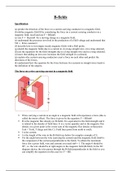Other
ATI Nursing Care of The Children 2019
- Institution
- Chamberlain College Of Nursing
ATI Nursing Care of The Children 2019. Dictatorial or authoritarian o Super strict parents, it’s their way or the highway o Parents try to control their child’s behaviors through unquestioned rules or expectations o Ex. the child is never allowed to watch tv on a school night § Permissive...
[Show more]












